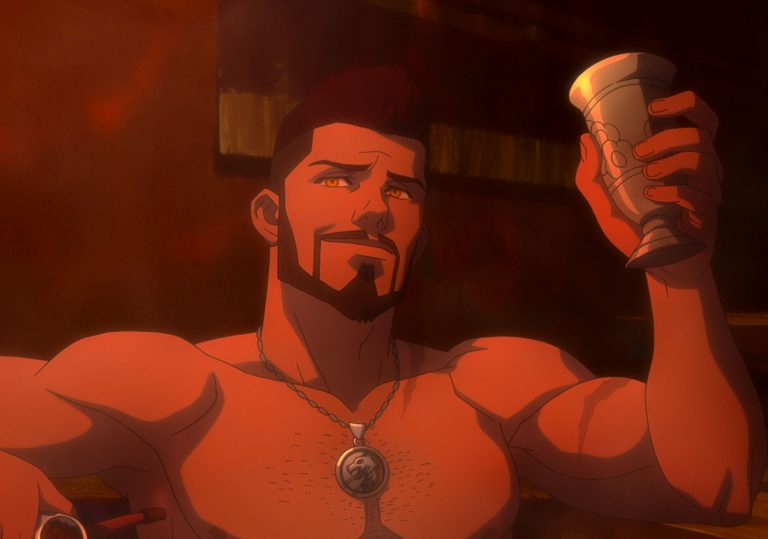NEWS
The Witcher: Nightmare of the Wolf
2021-08-25

The producers of Avatar prequel The Legend of Korra expand on Netflix’s dark fantasy series with a bloody “anime”.
Directed by KWANG IL HAN
Starring GRAHAM MCTAVISH LAURA PULVER THEO JAMES
*ANTICIPATION.
“Prestige TV movie supplement” isn’t so exciting, but “feature film from Studio Mir” very much is.
*ENJOYMENT.
Wouldn’t object to Netflix taking on a mission to make more adult fantasy animation.
*IN RETROSPECT.
Despite its efforts to deepen its fictional world, it’s mostly the action that stands out.
A new “anime” film from Netflix (a term they’ve thrown around with some generosity), The Witcher: Nightmare of the Wolf feels like confirmation of an exciting niche the streaming service has carved out in the realm of animation, mixing adult themes and genre thrills. Despite being dubbed an anime, producers Studio Mir are best known for their American animation work, having made their name with the Avatar sequel The Legend of Korra.
With that series, Mir more than proved their chops for creating compelling fantasy action grounded in believable but nonetheless wondrous movement. Directed by Han Kwang-Il, the film is set in the same fictional setting as the live-action The Witcher (showrunner Lauren Schmidt serves as producer here), in turn based on the books by Andrzej Sapkowski. Set before the time of Henry Cavill’s Geralt, Nightmare of the Wolf follows the youthful adventures of his senior, Vesemir, who carries himself with more authority and is always ready with a quip.
Like the show, lots of mythic proper nouns being thrown around might inspire some viewers who are unfamiliar with the medieval dark fantasy world of the books, game or series to keep the captions turned on. But screenwriter Beau DeMayo does well to keep audiences orientated through (if not necessarily interested in) the different threads of intrigue, keeping things firmly based in the racial tensions between humans, elves and witchers.
At the same time, we witness the tragedies and regrets of Vesemir’s past, his youthful ambition setting him on the path to freelance monster hunting. In the present day, Vesemir comes up against a mage who uses the killings of the film’s brutal opening as fodder for her fear-mongering campaign against witchers. Not that it’s completely unfounded – Han also details the horrific rites of passage that makes witchers, an inhumane series of tests that few survive. It’s all in service of fairly straightforward themes of humanity’s tendencies towards intolerance, building towards an inevitable conflict.
From the jump the film is horrifically bloody. No sooner are we introduced to a family of travellers in the opening scene than they are ruthlessly torn to pieces by a transforming monster – a ‘leshen’ – lurking in the woods. It turns from horror to wondrous action as Vesemir steps in, dispatching the creature with a dynamic onslaught of swordplay and magic. Dismemberment is treated remarkably gracefully here, the characters twirling and gliding through each layout. The animators consistently find interesting angles from which to frame the spectacle, even in the first person. This extends to the more mundane moments, viewed with equal detail and expressivity.
When it comes to the landscapes themselves, however, Nightmare of the Wolf is not the most exciting showcase of the geography of this world. Much of it comes across as fairly generic medieval fantasy, which isn’t helped by some flat lighting and an overbearing soundtrack of wailing singers. The bodies in motion are the film’s main draw, and between the flourishes of action, Han homes in on detailed close-ups which keep the violence from feeling overbearing even as Vesemir himself becomes numb to it.
In contrast to his more cynical witcher peer, Vesemir’s idealism reinforces his status as the unfortunate moral compass at the centre of a morally ambiguous conflict. The series may be misanthropic in tone, but its main character retains some hope that things can be fixed with reason. Despite this, Nightmare of the Wolf often feels as slight as the show that preceded it, even though it offers more depth and historical detail to their shared setting. It’s simply more interested in the monster-slaying, and when it moves as well as this does, who can blame it?
The Witcher: Nightmare of the Wolf review – Action-filled medieval fantasy (lwlies.com)




